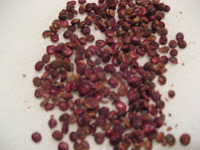

Poison or spice? It depends.
I knew to stay away from poison sumac (poison oak) because I learned that from my parents – especially when we had picnics on Garrett Mountain.
It wasn’t until I was learning the fine art of making dolma that I was introduced to the other sumac.
Sumac, the SPICE…
Should not be confused with the poisonous plant even though they are closely related.
Non-poisonous sumac is a berry that grows on a bush that grows wild in Mediterranean regions, and is a common ingredient in Middle Eastern cuisine.
You probably won’t find sumac in your everyday supermarket, but it’s a
regular feature on the shelves of Middle Eastern stores.
Its tart taste lends itself nicely as a substitute for lemon or vinegar.
Sumac is most often used in soups, stews, marinades, rice recipes, dolma (stuffed vegetables), dips, salads, salad dressings, or as a rub for meats.
If you happen to dine in a Persian or Middle Eastern restaurant, you’re likely to find a shaker on the table filled with ground sumac, much like the shakers of Parmesan cheese you see in Italian eateries.
Sts. Vartanantz Day is a moveable celebration on the Armenian Church calendar. This year it…
Just in time for soup season, Christine Datian offers The Armenian Kitchen her recipe for…
I don’t know about you, but in our family, we’re all about tradition when…
It’s that time of year again! St. Sarkis Day, the moveable feast day on the…
Way back in 2010 Ara Kassabian shared his family’s recipe for Nevik with The Armenian…
With Thanksgiving Day just hours away, I thought I’d share a few of our favorite,…
This website uses cookies. find out more.